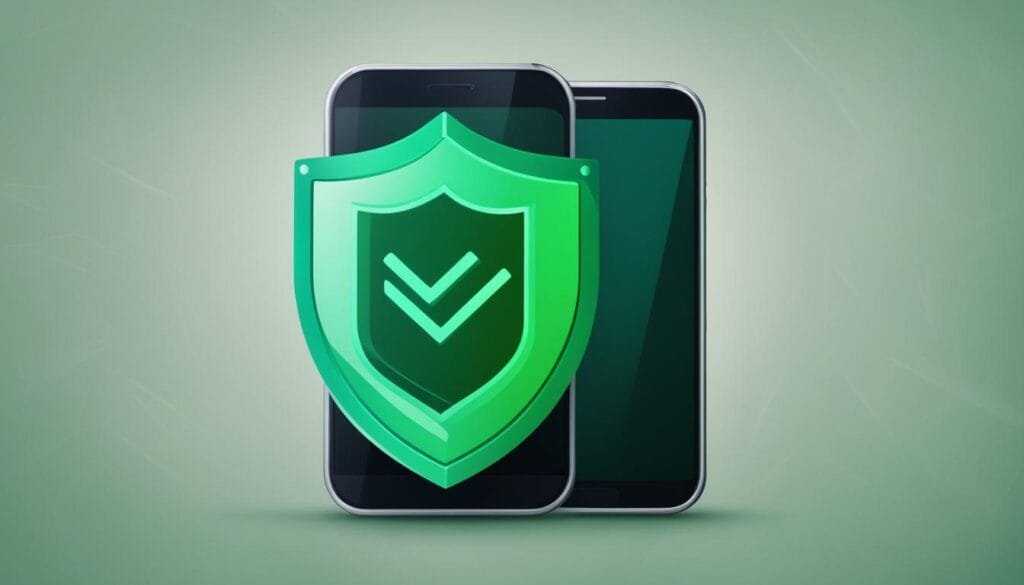Mobile banking has revolutionized the way we manage our finances, providing convenience and accessibility like never before. However, with the increasing use of mobile banking apps, it’s crucial to understand the importance of securing your transactions. By taking proactive measures and prioritizing transaction security, you can enjoy the benefits of mobile banking without compromising your financial safety.
When it comes to mobile banking, ensuring secure transactions is paramount. Encryption and secure payment gateways are essential features that protect your sensitive data from falling into the wrong hands. By utilizing these measures and staying informed about the latest fraud prevention techniques, you can safeguard your mobile transactions and enjoy peace of mind.
Mobile safety is a top concern when it comes to banking on the go. With cyber threats constantly evolving, it’s crucial to stay vigilant and adopt best practices to protect your financial information. By understanding the risks and implementing recommended security measures, you can confidently transact without fear, knowing that your mobile banking activities are secure.
Key Takeaways:
- Ensure your mobile banking app has encryption and secure payment gateways for secure transactions.
- Stay informed about the latest fraud prevention techniques to protect your financial data.
- Adopt best practices for mobile safety, such as using strong passwords and being cautious of phishing attempts.
- Regularly update your mobile banking app to benefit from the latest security enhancements.
- Contact your bank or credit union for additional security measures and assistance when needed.
The Risks of Mobile Banking: What Could Happen To You?
Mobile banking has revolutionized the way we manage our finances, allowing us to conveniently access our accounts and make transactions on the go. However, it’s crucial to be aware of the potential risks associated with mobile banking to protect ourselves from data breaches and identity theft.
One of the primary risks of mobile banking is the possibility of data breaches. Hackers can exploit vulnerabilities in mobile banking apps, gaining unauthorized access to personal and financial information. This can lead to significant financial loss and potential damage to your credit score.
Identity theft is another concern when it comes to mobile banking. Cybercriminals may attempt to steal your personal information, such as social security numbers and passwords, to impersonate you and gain access to your financial accounts. This can result in unauthorized transactions and even create long-term financial and legal consequences.
“Mobile banking poses risks such as mobile malware, SIM swaps, fake banking apps, and more.”
It’s important to note that not all mobile banking apps are created equal. Studies have found that a significant number of these apps have security vulnerabilities that could potentially be exploited by hackers. Therefore, it’s crucial to choose reputable and well-established banking apps that prioritize security and regularly update their systems to address any identified vulnerabilities.
The Risks of Mobile Banking: What Could Happen To You?
| Risk | Description |
|---|---|
| Data Breaches | Hackers exploit vulnerabilities in mobile banking apps, gaining access to personal and financial information. |
| Identity Theft | Cybercriminals steal personal information to impersonate individuals and gain unauthorized access to financial accounts. |
Being aware of these risks is the first step in protecting yourself while using mobile banking. It’s important to follow best practices, such as using strong and unique passwords, enabling two-factor authentication, and regularly updating your mobile banking app. Additionally, be cautious of phishing attempts and only download apps from legitimate sources such as official app stores. By taking these precautions, you can minimize the chances of falling victim to mobile banking risks and ensure a secure banking experience.
Protecting Your Mobile Transactions: Best Practices
When it comes to mobile banking, security should be your top priority. By following best practices, you can safeguard your mobile transactions and ensure the safety of your financial data. Here are some key measures you should take:
Enable Two-Factor Authentication
Two-factor authentication adds an extra layer of security to your mobile banking app. It requires you to provide two forms of identification, such as a password and a unique code sent to your mobile device, to access your account. By enabling this feature, you can significantly reduce the risk of unauthorized access even if your password is compromised.
Be Cautious of Phishing Attempts
Phishing is a common technique used by scammers to trick users into revealing their sensitive information. Be wary of any suspicious emails, text messages, or phone calls that ask for your banking details. Legitimate financial institutions will never ask you to provide your personal information through these channels. If you receive such requests, report them to your bank immediately.
Use Strong and Unique Passwords
Creating strong and unique passwords for your mobile banking app is crucial. Avoid using easily guessable passwords such as birthdays or names. Instead, use a combination of uppercase and lowercase letters, numbers, and symbols. Additionally, make sure to use different passwords for each of your online accounts to prevent unauthorized access in case one password is compromised.
Regularly Update Your Mobile Banking App
Keeping your mobile banking app up to date is essential for maintaining its security. App updates often include security patches and bug fixes that address known vulnerabilities. By regularly updating your app, you can ensure that you have the latest security measures in place to protect your transactions and data.
By implementing these best practices, you can enhance the security of your mobile transactions and minimize the risk of unauthorized access or fraud. Remember, it’s essential to stay vigilant and take proactive steps to protect yourself in the ever-evolving world of mobile banking.
Ensuring Secure Payments: Mobile Banking Tools and Features
Mobile banking apps offer a range of tools and features that can enhance the security of your payments and provide you with peace of mind. These features are designed to give you greater control over your transactions and protect your financial information from unauthorized access. By leveraging these tools, you can stay informed about your account activity and respond swiftly to any suspicious transactions.
Mobile Check Deposit
One of the convenient features offered by mobile banking apps is the ability to deposit checks using your smartphone. Instead of visiting a physical branch or ATM, you can simply capture an image of the check and submit it through the app. This not only saves you time and effort but also reduces the risk of losing or misplacing the check. Mobile check deposits are typically processed quickly, allowing you to access your funds sooner.
Transaction Notifications
To keep you informed about your account activity, mobile banking apps offer real-time transaction notifications. Whenever a transaction is made on your account, such as a purchase or withdrawal, you will receive an instant notification on your mobile device. These notifications enable you to monitor your transactions closely and quickly identify any unauthorized activity. By promptly reporting any suspicious transactions to your bank, you can take action to prevent potential fraud.
Funds Availability
Mobile banking apps also provide information about the availability of funds in your account. This feature allows you to know when deposited funds will be accessible and when any holds or restrictions may apply. By having a clear understanding of when your funds will be available, you can plan your finances accordingly and avoid any potential overdrafts or insufficient fund fees.
| Mobile Banking Tools and Features | Description |
|---|---|
| Mobile Check Deposit | Allows you to deposit checks using your smartphone, saving time and effort. |
| Transaction Notifications | Provides real-time notifications for every transaction made on your account, enabling you to monitor your activity closely. |
| Funds Availability | Informs you about the availability of deposited funds, helping you plan your finances effectively. |
In conclusion, the tools and features offered by mobile banking apps play a vital role in ensuring secure payments. By leveraging the convenience of mobile check deposits, staying informed through transaction notifications, and understanding the availability of funds, you can protect your financial information and stay in control of your banking transactions.
Conclusion
Securing your mobile banking transactions is crucial to safeguarding your financial information and protecting yourself from potential risks. While mobile banking offers convenience and ease of use, it also exposes your account to various vulnerabilities. By understanding the risks associated with mobile banking and implementing best practices, you can ensure a safe and secure banking experience.
It is essential to be aware of the potential risks, such as data breaches, identity theft, and fraudulent apps. To mitigate these risks, enable two-factor authentication, use strong and unique passwords, and stay cautious of phishing attempts. Regularly updating your mobile banking app and downloading from legitimate app stores will also help enhance security.
Furthermore, take advantage of the security tools and features offered by mobile banking apps. Features like mobile check deposit, real-time transaction notifications, and funds availability policies enable you to closely monitor your account activity and identify any unauthorized transactions promptly.
In conclusion, prioritize mobile banking safety by staying informed, implementing best practices, and utilizing available security features. By doing so, you can transact without fear and enjoy the convenience of mobile banking, knowing that you have taken the necessary steps to protect your financial well-being.
FAQ
What are the risks of using mobile banking apps?
The risks of using mobile banking apps include the theft of personal information, remote access by hackers, and identity theft. Studies have shown that many mobile banking apps have security vulnerabilities that could lead to data breaches and financial fraud.
How can I protect my mobile banking transactions?
To safeguard your mobile banking transactions, you should enable two-factor authentication, be cautious of phishing attempts, use strong and unique passwords, and regularly update your mobile banking app. It is also important to download apps only from legitimate app stores and check for signs of fraudulent apps.
What tools and features do mobile banking apps offer to enhance security?
Mobile banking apps offer various tools and features such as the ability to deposit checks using your smartphone, real-time transaction notifications, and funds availability policies. These features allow you to closely monitor your account activity, detect any suspicious transactions, and take immediate action to mitigate potential risks.
How can I ensure the security of my mobile payments?
To ensure secure payments, it is crucial to stay vigilant, keep your mobile banking app and device up to date, and contact your bank or credit union for additional security measures and assistance when needed.
What are the Best Security Measures for Mobile Banking?
Ensuring mobile banking security for children is crucial in today’s digital world. Parents should educate their children about the importance of using strong passwords and not sharing sensitive information online. Implementing biometric authentication and enabling two-factor authentication can add an extra layer of protection. Regularly updating the banking app and keeping an eye on transactions help detect any potential fraudulent activity. Transacting only through secure and trusted networks is equally important for safeguarding children’s mobile banking activities.

